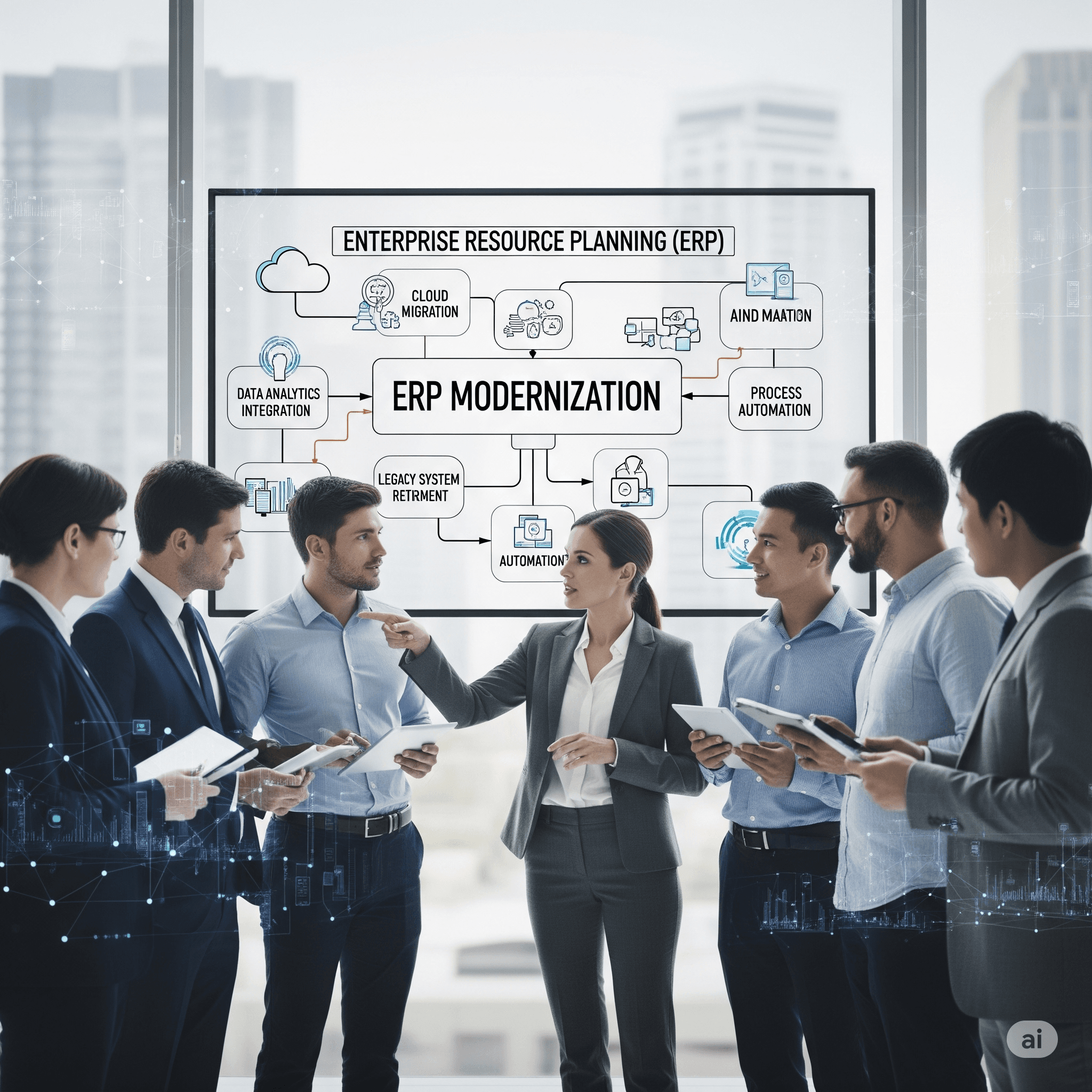Building Scalable Enterprise Architectures
Comprehensive guide to designing and implementing scalable enterprise architectures that support business growth, ensure resilience, and enable digital transformation through modern architectural patterns and best practices.

Introduction
Understanding Enterprise-Scale Architecture Requirements
Enterprise-scale architecture requirements differ fundamentally from smaller applications due to the complexity of supporting millions of users, massive data volumes, regulatory compliance, and integration with legacy systems that may be decades old but still run critical business processes. The SCALE framework provides structured guidance for balancing innovation with stability through Strategic Assessment, Controlled Architecture, Limited blast radius implementation, Automated processes, and Evolutionary design that addresses common pitfalls in enterprise transformation. Enterprise systems must achieve sub-second response times globally while maintaining data consistency, security, and compliance across distributed infrastructure that spans multiple cloud providers, on-premises data centers, and edge locations.

Enterprise Complexity Factors
Enterprise architectures must address scale (millions of transactions daily), integration (100+ interconnected systems), compliance (GDPR, HIPAA, SOX requirements), performance (sub-second global response), legacy constraints (20+ year old systems), and data volume (petabytes requiring real-time processing).
- Massive Scale Operations: Handling millions of concurrent users and transactions while maintaining consistent performance and availability
- Complex System Integration: Connecting diverse systems through various protocols while maintaining data consistency and security
- Regulatory Compliance: Meeting stringent requirements for data protection, audit trails, and industry-specific regulations
- Global Performance: Delivering sub-second response times across multiple geographic regions and time zones
- Legacy System Integration: Incorporating decades-old systems that run critical processes while enabling modernization
- Data Volume Management: Processing and analyzing petabytes of data in real-time for business intelligence and operations
Architectural Patterns for Enterprise Scalability
Choosing appropriate architectural patterns is crucial for enterprise scalability, with decisions depending on factors including team size, domain complexity, scaling requirements, deployment frequency, data models, and maintenance approaches. The monolith-to-microservices decision matrix helps organizations evaluate whether microservices architecture is appropriate, with microservices being suitable for teams larger than 20 developers, complex domains, variable demands, daily updates, domain-specific data models, and distributed ownership. Event-driven architectures provide loose coupling and scalability benefits for real-time systems, while serverless architectures offer automatic scaling and reduced operational overhead for variable workloads.
| Architecture Pattern | Best Use Cases | Scalability Benefits | Implementation Considerations |
|---|---|---|---|
| Monolithic Architecture | Small teams (<10 developers), simple domains, predictable loads | Simplified development, centralized deployment, unified data model | Limited scalability, single point of failure, deployment constraints |
| Microservices Architecture | Large teams (>20 developers), complex domains, variable demands | Independent scaling, technology diversity, fault isolation | Increased complexity, distributed system challenges, operational overhead |
| Service-Oriented Architecture | Enterprise integration, legacy modernization, reusable services | Service reusability, standardized communication, enterprise integration | Service governance, performance overhead, complexity management |
| Event-Driven Architecture | Real-time processing, IoT systems, reactive applications | Loose coupling, asynchronous processing, dynamic scalability | Event ordering, eventual consistency, debugging complexity |
Horizontal vs Vertical Scaling Strategies
Modern enterprise architectures favor horizontal scaling approaches that add more machines and distribute workloads across servers rather than vertical scaling that upgrades existing machines with additional resources. Horizontal scaling offers near-limitless scaling potential, improved fault tolerance, and support for parallel processing, though it requires more complex management compared to vertical scaling. Effective horizontal scaling relies on distributed processing that breaks large tasks across nodes, data partitioning and sharding that divides datasets into independent chunks, and asynchronous communication using message queues for component interaction.
Horizontal Scaling Advantages
Horizontal scaling provides near-limitless scaling potential, improved fault tolerance through redundancy, and better cost-effectiveness compared to vertical scaling, making it the preferred approach for enterprise architectures.
Modular Design and Loose Coupling Principles
Modular design and loose coupling represent fundamental principles for scalable enterprise architecture, enabling independent scaling of components, reducing system complexity, and facilitating maintenance and evolution over time. Modular systems ensure that each component operates independently, reducing the risk of single failures affecting the entire system while enabling teams to develop, deploy, and scale services autonomously. Loose coupling minimizes dependencies between components, allowing for easier upgrades, technology changes, and integrations as business requirements evolve without disrupting other parts of the system.

Cloud-Native Architecture and Container Technologies
Cloud-native architectures leverage containerization, orchestration platforms like Kubernetes, and serverless technologies to achieve elastic scalability, operational efficiency, and rapid deployment capabilities essential for modern enterprise systems. Containerization provides consistent deployment environments across development, testing, and production while enabling efficient resource utilization and simplified scaling through orchestration platforms. Serverless computing allows developers to focus on business logic without managing infrastructure, providing automatic scaling based on demand and cost-effective execution for variable workloads.
- Container Orchestration: Kubernetes and similar platforms manage container lifecycle, scaling, and resource allocation automatically
- Serverless Functions: Event-driven execution model that scales automatically and reduces operational overhead
- Cloud-Native Services: Managed databases, messaging systems, and AI services that eliminate infrastructure management
- DevOps Integration: Continuous integration and deployment pipelines that support rapid, reliable software delivery
- Infrastructure as Code: Version-controlled infrastructure definitions that enable consistent, repeatable deployments
Performance Optimization and Caching Strategies
Performance optimization in scalable enterprise architectures requires comprehensive caching strategies, load balancing mechanisms, and data access optimization that work together to deliver consistent performance under varying load conditions. Effective caching involves multiple layers including in-memory data stores like Redis or Memcached, content delivery networks for global content distribution, and application-level caching that reduces database load while improving response times. Advanced optimization techniques include asynchronous processing for time-consuming tasks, database query optimization, and intelligent load balancing that distributes requests based on server capacity and geographic proximity.
| Optimization Strategy | Implementation Approach | Performance Impact | Scalability Benefits |
|---|---|---|---|
| Multi-Layer Caching | Redis, Memcached, CDN integration | Reduced latency, lower database load | Improved response times at scale |
| Load Balancing | Application load balancers, geographic distribution | Even traffic distribution, fault tolerance | Horizontal scaling support, high availability |
| Asynchronous Processing | Message queues, background job processing | Improved user experience, resource optimization | Decoupled systems, independent scaling |
| Database Optimization | Query optimization, indexing, sharding | Faster data access, reduced resource consumption | Data layer scalability, parallel processing |
Data Architecture and Distributed Systems
Scalable enterprise architectures require sophisticated data architecture strategies that combine distributed storage systems, data replication, partitioning techniques, and consistency models that support high availability while maintaining data integrity. Modern data architectures integrate data lakes for diverse raw data formats with data warehouses optimized for analytics, creating comprehensive data platforms that support both operational and analytical workloads. Distributed database strategies including sharding, replication, and eventual consistency models enable systems to handle massive data volumes while providing acceptable performance and availability characteristics.
Security Architecture and Zero Trust Principles
Enterprise security architecture must implement Zero Trust principles that assume no implicit trust and require verification for every user, device, and network component accessing system resources. Security integration includes implementing role-based access control (RBAC), encryption for data at rest and in transit, comprehensive audit logging, and continuous security monitoring that adapts to evolving threat landscapes. Modern security architectures embed security controls throughout the development lifecycle, implement automated compliance monitoring, and provide defense-in-depth strategies that protect against both external threats and insider risks.
Security-First Design
Zero Trust security models require verification for every access request and assume breach scenarios, making security architecture an integral part of scalable enterprise design rather than an afterthought.
API Design and Integration Architecture
API-first architecture approaches enable scalable enterprise systems through well-designed, versioned APIs that support integration, extensibility, and evolution without breaking existing functionality. Robust API design includes standardized protocols like REST or GraphQL, comprehensive documentation, versioning strategies, and security controls that enable both internal service communication and external partner integration. API management platforms provide governance, monitoring, and lifecycle management capabilities that ensure APIs remain reliable, performant, and secure as systems scale and evolve.

Fault Tolerance and Resilience Patterns
Building resilient enterprise architectures requires implementing fault tolerance patterns that protect against failures while maintaining service availability through circuit breakers, bulkhead patterns, graceful degradation, and progressive rollout strategies. Circuit breakers prevent cascade failures by failing fast when dependent services are unavailable, while bulkhead patterns isolate critical resources from experimental features to maintain core functionality during partial system failures. Advanced resilience patterns include timeout management, retry mechanisms with exponential backoff, and chaos engineering practices that proactively test system resilience under failure conditions.
- Circuit Breaker Pattern: Prevents cascade failures by detecting service unavailability and failing fast to protect upstream systems
- Bulkhead Isolation: Separates system resources to prevent failures in one component from affecting critical functionality
- Graceful Degradation: Maintains core functionality even when non-critical features or services become unavailable
- Progressive Rollout: Minimizes change impact through gradual deployment and automatic rollback capabilities
- Chaos Engineering: Proactive testing of system resilience through controlled failure injection and recovery validation
DevOps and Continuous Deployment Integration
Scalable enterprise architectures require DevOps practices that enable rapid, reliable software delivery through automated testing, continuous integration, and deployment pipelines that maintain quality while supporting frequent releases. Modern DevOps approaches include infrastructure as code, automated testing at multiple levels, continuous monitoring, and feedback loops that enable teams to detect and resolve issues quickly. Advanced practices include blue-green deployments, canary releases, and feature flags that enable safe deployment of changes while minimizing risk to production systems.
Monitoring, Observability, and Performance Management
Comprehensive monitoring and observability are essential for managing scalable enterprise architectures, providing visibility into system performance, user experience, and business metrics that enable proactive problem resolution and optimization. Modern observability platforms combine metrics, logs, and distributed tracing to provide holistic views of system behavior across complex, distributed architectures while enabling rapid troubleshooting and root cause analysis. Advanced monitoring includes application performance monitoring, infrastructure monitoring, security monitoring, and business metrics tracking that provide actionable insights for continuous improvement.
| Monitoring Category | Key Metrics | Tools and Techniques | Business Value |
|---|---|---|---|
| Application Performance | Response time, throughput, error rates, user experience | APM tools, synthetic monitoring, real user monitoring | Improved user satisfaction, performance optimization |
| Infrastructure Monitoring | CPU, memory, storage, network utilization | Infrastructure monitoring platforms, alerting systems | Resource optimization, capacity planning, cost control |
| Security Monitoring | Access patterns, threat detection, compliance metrics | SIEM platforms, security analytics, threat intelligence | Risk reduction, compliance assurance, incident response |
| Business Metrics | Revenue impact, user engagement, conversion rates | Business intelligence platforms, custom dashboards | Data-driven decisions, business outcome tracking |
Cost Optimization and Resource Management
Enterprise architecture scalability must balance performance requirements with cost optimization through intelligent resource management, automated scaling policies, and usage-based optimization strategies. Cloud-native cost optimization includes rightsizing resources based on actual usage patterns, implementing auto-scaling policies that respond to demand changes, and leveraging reserved instances or committed use discounts for predictable workloads. Advanced cost management involves monitoring and analyzing cost patterns, implementing cost allocation and chargeback mechanisms, and continuously optimizing resource utilization based on business value and performance requirements.
Legacy System Integration and Modernization
Enterprise architectures must accommodate legacy systems that may be decades old but still run critical business processes, requiring integration strategies that enable modernization without disrupting operations. Legacy modernization approaches include API wrapper patterns that provide modern interfaces to legacy systems, event-driven integration that decouples legacy systems from modern applications, and gradual migration strategies that replace functionality incrementally. The strangler fig pattern enables gradual replacement of legacy functionality by routing increasing amounts of traffic to new systems while maintaining backward compatibility.
Legacy Integration Strategy
Successful legacy modernization requires incremental approaches that minimize risk while enabling innovation, using patterns like API wrappers, event-driven integration, and strangler fig replacement strategies.
Organizational Architecture and Team Scaling
Scalable enterprise architecture requires corresponding organizational structures that support distributed development, ownership, and decision-making aligned with system boundaries and business capabilities. Conway's Law suggests that system architecture reflects organizational communication structures, making it essential to design team boundaries that align with desired system architecture. Effective organizational patterns include cross-functional teams responsible for specific business capabilities, platform teams that provide shared services, and center of excellence groups that establish standards and best practices.
Governance and Architecture Standards
Enterprise architecture governance provides the frameworks, standards, and decision-making processes that ensure architectural consistency, quality, and alignment with business objectives across large, distributed organizations. Governance frameworks include architecture review processes, technology standards, decision rights and accountabilities, and metrics that measure architectural effectiveness and business value. Modern governance approaches balance control with agility through automated policy enforcement, architecture as code practices, and self-service platforms that enable teams to innovate within established guardrails.
Future Trends and Emerging Technologies
The future of enterprise architecture will be shaped by emerging technologies including artificial intelligence for automated optimization, edge computing for distributed processing, quantum computing for complex problem-solving, and advanced automation that reduces operational overhead. AI-powered architecture optimization will automatically adjust resource allocation, detect performance anomalies, and recommend architectural improvements based on usage patterns and business objectives. Edge computing architectures will bring processing closer to users and data sources, while maintaining centralized governance and security controls across distributed infrastructure.
- AI-Powered Optimization: Automated resource allocation, performance tuning, and architectural decision-making based on machine learning
- Edge Computing Integration: Distributed processing capabilities that maintain centralized governance while enabling local optimization
- Quantum Computing Applications: Advanced computational capabilities for complex optimization, cryptography, and machine learning workloads
- Autonomous Operations: Self-healing systems that automatically detect, diagnose, and resolve operational issues without human intervention
- Advanced Security: Quantum-resistant cryptography, AI-powered threat detection, and adaptive security controls that evolve with threats
Implementation Roadmap and Best Practices
Implementing scalable enterprise architecture requires a structured approach that begins with strategic assessment and alignment, progresses through controlled architecture implementation, and evolves through continuous improvement and optimization. Best practices include starting with clear business objectives and success criteria, implementing changes incrementally with limited blast radius, and building organizational capabilities through training and experience. The implementation roadmap should prioritize high-impact, low-risk improvements while building toward more significant architectural transformations that deliver strategic value.
| Implementation Phase | Key Activities | Timeline | Success Criteria |
|---|---|---|---|
| Assessment and Planning | Current state analysis, strategy definition, roadmap creation | 2-3 months | Clear vision, stakeholder alignment, detailed roadmap |
| Foundation Building | Core infrastructure, CI/CD pipelines, monitoring systems | 3-6 months | Operational platform, automated deployments, visibility |
| Incremental Modernization | Service extraction, API development, legacy integration | 6-18 months | Improved agility, reduced technical debt, enhanced capability |
| Scale and Optimize | Performance tuning, advanced patterns, global deployment | 12-24 months | Enterprise scale, optimal performance, business transformation |
Measuring Success and ROI
Measuring the success of scalable enterprise architecture initiatives requires comprehensive metrics that capture technical improvements, business value, and organizational benefits achieved through architectural transformation. Key performance indicators include system performance metrics like response time and availability, development velocity measures such as deployment frequency and lead time, and business impact measurements including revenue growth and operational efficiency. Organizations should establish baseline measurements before implementation and track progress regularly to demonstrate value and identify areas for continued optimization.
Conclusion
Building scalable enterprise architectures represents a fundamental capability for organizations seeking to thrive in digital-first business environments where technical scalability, organizational agility, and business innovation must work together to create sustainable competitive advantages. Success requires combining proven architectural patterns with modern technologies, cloud-native platforms, and intelligent automation while addressing the unique challenges of enterprise scale including regulatory compliance, legacy system integration, and complex stakeholder requirements. The most effective enterprise architectures achieve scalability through modular design, loose coupling, fault tolerance, and comprehensive observability while building organizational capabilities that support continuous evolution and improvement. As technology continues to advance with AI-powered optimization, edge computing, and autonomous operations, organizations that invest in scalable architecture foundations and build corresponding organizational capabilities will be best positioned to leverage these innovations for competitive advantage and business transformation. The future belongs to enterprises that can balance stability with innovation through intelligent architecture that scales not just technically but organizationally, enabling rapid adaptation to changing market conditions while maintaining operational excellence and regulatory compliance at global scale.
Reading Progress
0% completed
Article Insights
Share Article
Quick Actions
Stay Updated
Join 12k+ readers worldwide
Get the latest insights, tutorials, and industry news delivered straight to your inbox. No spam, just quality content.
Unsubscribe at any time. No spam, ever. 🚀
